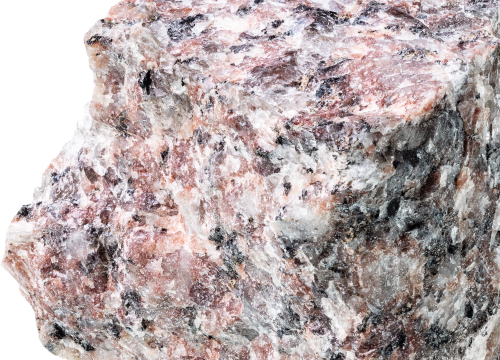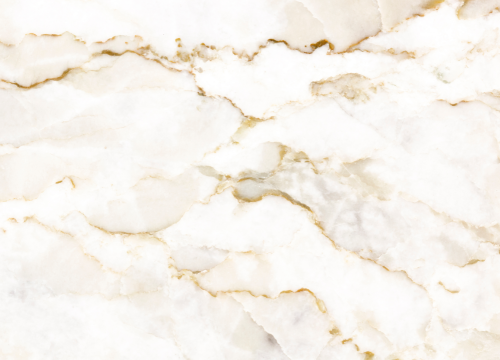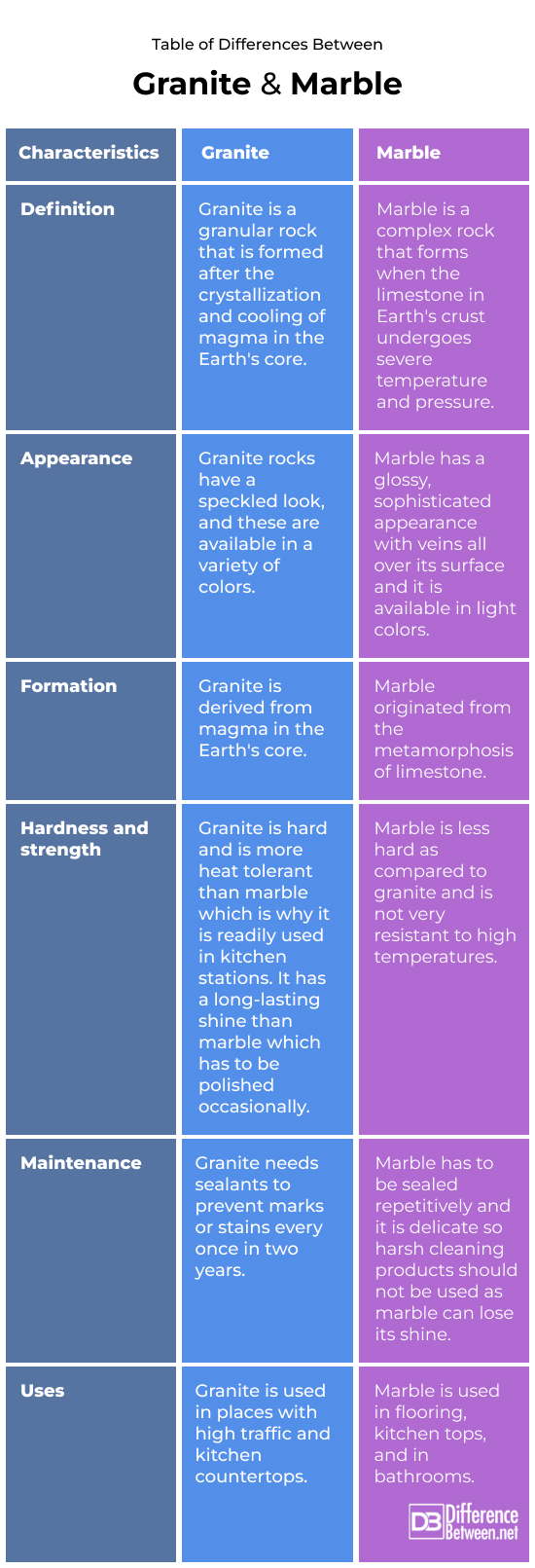Difference Between Granite and Marble
Granite and marble are both most prevalent choices for natural stone surfaces, each has different characteristics which make them suitable for various purposes.
Granite, an igneous rock formed from cooled magma, is recognised for its durability and resistance to scratches and heat. It has a granular texture and comes in a different range of colors and patterns, used as a versatile option for countertops, flooring, and other architectural designing needs.
On the other hand, marble, a metamorphic rock composed of crystallized limestone. It has elegance and unique veining patterns. Marble is softer than granite, it has a smoother finish and a luxurious aesthetic which often makes it a favoured choice for using as countertops, flooring, and decorative accents.
Both materials require appropriate maintenance, with granite which is more resistant to stains and scratches, while marble can be more susceptible to etching from acidic substances.

What is granite?
Definition:
Granite is a granular rock that is formed after the crystallization and cooling of magma in the Earth’s core. Granite is characterized by its durable composition, consisting of quartz, feldspar, and mica minerals. It has a distinctive granular texture and comes in a wide range of colors, including pink, gray, black, white, and brown.
Famous for its hardness and resistance to wear. It is a natural stone used in construction and architecture for applications such as countertops, flooring, and monuments.
Granite has the ability to withstand heat, scratches, and stains makes it popular for kitchen surfaces. Not only used for its practical uses, granite has a natural beauty and unique patterns and therefore it is used as material for artistic and decorative purposes, including sculptures and gravestones.
Appearance:
Granite rocks have a speckled look and these are available in a variety of colors.
Formation:
Granite is derived from magma in the Earth’s core.
Hardness and strength:
Granite is hard and is more heat tolerant than marble which is why it is readily used in kitchen stations. It has a long-lasting shine than marble which has to be polished occasionally.
Maintenance:
Granite needs sealants to prevent marks or stains every once in two years.
Uses:
Granite is used in places with high traffic and kitchen countertops.

What is marble?
Definition:
Marble is a metamorphic rock formed from the recrystallization of limestone under high heat and pressure. Composed of calcite or dolomite minerals. Marble is famous for its distinctive veining patterns and a smooth, polished surface for luxurious aesthetic. Available in a different colors, including white, gray, green, and various earth tones. It has been used as a material for sculptures, architectural designs, and ornamental surfaces. It is softer than granite, making it more susceptible to scratches and acids. Because of its appeal, marble is a popular choice for countertops, flooring, and decorative accents.
Appearance:
Marble has a glossy, sophisticated appearance with veins all over its surface and it is available in light colors.
Formation:
Marble originated from the metamorphosis of limestone.
Hardness and strength:
Marble is less hard as compared to granite and is not very resistant to high temperatures.
Maintenance:
Marble has to be sealed repetitively and it is delicate so harsh cleaning products should not be used as marble can lose its shine.
Uses:
Marble is used in flooring, kitchen tops, and in bathrooms.
Difference Between Granite and Marble
Definition:
Granite is a granular rock that is formed after the crystallization and cooling of magma in the Earth’s core. Marble is a complex rock that forms when the limestone in Earth’s crust undergoes severe temperature and pressure.
Appearance:
Granite rocks have a speckled look and these are available in a variety of colors. Marble has a glossy, sophisticated appearance with veins all over its surface and it is available in light colors.
Formation:
Granite is derived from magma in the Earth’s core.
Marble originated from the metamorphosis of limestone.
Hardness and strength:
Granite is hard and is more heat tolerant than marble which is why it is readily used in kitchen stations. It has a long-lasting shine than marble which has to be polished occasionally.
Marble is less hard as compared to granite and is not very resistant to high temperatures.
Maintenance:
Granite needs sealants to prevent marks or stains every once in two years.
Marble has to be sealed repetitively and it is delicate so harsh cleaning products should not be used as marble can lose its shine.
Uses:
Granite is used in places with high traffic and kitchen countertops.
Marble is used in flooring, kitchen tops, and in bathrooms.
Table of difference Between Granite and Marble

FAQs
Which is better marble or granite?
In terms of durability and strength, granite is better than marble.
Is granite more expensive than marble?
Marble is costly as compared to granite.
How do I tell the difference between granite and marble?
Marble surfaces will show scratches with time whereas granite surfaces will not.
Does granite or marble stain easily?
Marble tends to stain more readily than granite.
What are the disadvantages of marble countertops?
Does marble scratch easier than granite?
Yes.
Is quartz or granite better?
Granite offers a sleek unique look which is better in terms of appearance as compared to more durable quartz therefore granite is preferred.
What color of granite is the most expensive?
Red and blue granite.
Does granite last longer than marble?
Yes.
Which is better for kitchen granite or marble?
Granite.
Which is colder marble or granite?
Granite is cooler than marble.
Which is better Italian marble or granite?
Italian marble is preferred because of its luxurious aesthetics.
- Differences Between Reptiles and Amphibians - May 17, 2024
- Difference Between Ophthalmology and Optometry - May 15, 2024
- Difference Between Fear and Anxiety - April 2, 2024
Search DifferenceBetween.net :
1 Comment
Leave a Response
References :
[0]Brown, Michael. "Granite: From genesis to emplacement." GSA bulletin 125.7-8 (2013): 1079-1113.
[1]Maynard, Nigel F. "Rock on: should you spec granite in your next kitchen or counter with quartz?." Residential Architect 9.8 (2005): 101-103.
[2]Hamza, Rania A., Salah El-Haggar, and Safwan Khedr. "Marble and granite waste: characterization and utilization in concrete bricks." International Journal of Bioscience, Biochemistry and Bioinformatics 1.4 (2011): 286-291.
[3]Image credit: https://www.canva.com/photos/MADerPLCKps-marble/
[4]Image credit: https://www.canva.com/photos/MAES59RmIFI-rough-pink-granite-rock-cutout/

thank you for this information and clarifications .
I would like if you translate this sheet to arabic